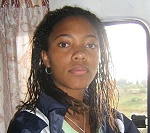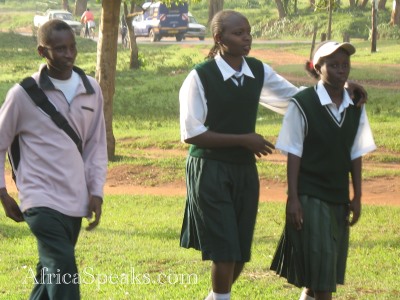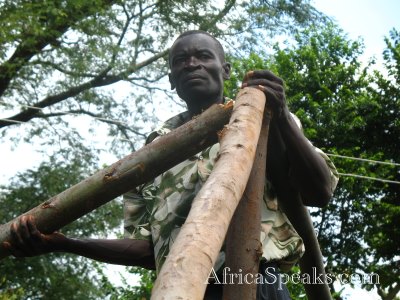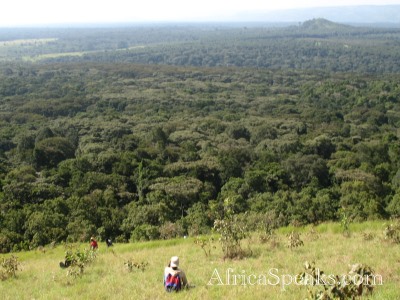The original URL of this article is:
www.africaspeaks.com/kenya/16122006.html
Michelle's Experience in Kenya - Pt II
Continuation from: Michelle's Experience in Kenya Pt - I
by Michelle Allum
Posted: December 16, 2006
UWI Students Trip to Kenya
 | | | Michelle Allum | |
Circumcision - Male and Female
As you can see, it is easier to trace the family by the group the father was circumcised in. The group would be named after an event that occurred around the time of their Circumcision Festival e.g. "Uhuru" which means "freedom" in Kiswahili is one such name and is associated with the Mau Mau struggle for independence which took place at that time. This largely-celebrated Circumcision Festival takes place in the month of August, every for years. The boys in the village, aged 10 to 14 go through preparation for a couple of months to take the pain without expressing the hurt (if one cries or winces, it is remembered forever and he is treated like an outcast, not respected by the village, finds difficulty in getting a job, etc.) They are also taught to behave as a man is expected to in the village, as that will be their title from then on if the ceremony was a success. From this day, the son is respected as "a man" by everyone in the village, including his mother. He is no longer allowed to enter his mother's hut or sleep on her bed.
Interestingly enough, female circumcision is also still practiced by the Kikuyu tribe, and it is a matter of cultural pride. No one is forced but there is definitely societal pressure to do so, as choosing not to participate comes off as rebellion against your own culture and people. It even affects the dowry that a family receives for their daughter. I thought that perhaps male circumcision, was practised for hygiene, however, like female circumcision, it is more a cultural issue.
According to Mr. Edward Muyundo, Assistant Chief of the Lunao area, the practice began during times of tribal wars when many women were having children out of marriage. In an attempt to "reduce the sexual urge", this measure was adopted so that when the men came back from war, their wives would be as they had left them.
Now, perception has a great impact on what we think is right or wrong. I believe that many people have customs that may appear strange, even blasphemous, to outsiders who are not part of the culture or do not understand its origin or purpose.
Male circumcision is not regarded as mutilation of the body in our culture, so if in Kenyan culture, female circumcision was not looked at in this way either, I would have had to understand the cultural difference, even if the actual act seems wrong to me. However, although some women still pass on the tradition by allowing their daughters to be circumcised, probably due to the internal social pressure, there has been significant protest against it by many others.
 | | Children walk from School in Kitale |
Religion
The group of delegates had a wide range of religious beliefs, representing the reality of Trinidad and Tobago quite well. Some were Roman Catholic (including myself), Anglican, Methodist, Muslim, Rastafarian and yet others who do not believe in "structured" religion. Contrary to this, most of the people we interacted with in Kenya; the KVDS volunteers, the self help groups, the children in the schools, were either Catholic or belonged to another form of Christianity. We met one male Muslim, Habib, in Bungoma town. The students in the schools we visited seemed to have had very limited actual contact with Muslims. They expressed surprise at seeing a Muslim in our delegation. This is probably because most Muslims live in the more northern regions of Africa. I am unaware of the range of religions practised in Kenya because most of the places and people we visited were Christian.
During our time in Bungoma, Mr. Malaho (a Christian) invited our group to his church on Sunday mornings. The service seemed similar to what would transpire in a Pentecostal or Baptist church, with loud singing, drumming and dancing and a time for witnessing where members of the congregation shared the experiences of "God" in their lives. There were a lot more men in this church than I am accustomed seeing in Catholic Mass in Trinidad, where the great majority of parishioners are women.
They sang in Kiswahili and though I did not know their words, I felt their meaning. I appreciated the experience for what it was. We stood there together, joining in the praise of one higher being, even though according to "religion" we may have shared entirely different views on its essence.
While in Kakamega, we stayed at the St. Nicholas Catholic Centre. In many ways what encompassed being Roman Catholic in Trinidad, appeared to be the same as in Kenya. At the Centre there were nuns carrying rosaries, mass was held every morning at 6 a.m. with the priest offering of communion on the altar, there were pictures of Jesus on the walls and statues of Mary and the Saints in the garden. These were regular sights for me while attending my secondary school Holy Name Convent.
Late one night we heard loud shouts and screams coming from the village. The screams continued for quite some time and then we began hearing drums. Apparently an old lady from the village died that day. The screaming and moaning was the ritual method of passing the message of the person's death from village to village as part of the wake. As in Trinidad, many older ladies and children gathered in the hut of the deceased to pay their respects. A financial offering was asked of the visitors to the house, to aid the family left behind.
In Kenya, the body of the deceased is usually kept in front of the house in an opened coffin during the week of the wake, but that night it was raining so the body was kept inside. Another difference to the Catholic practices in Trinidad was that the body is buried right in front the person's house, the same plot being shared by a married couple. There is no concept of graveyards behind churches which is a commonly practised by Trinbagonian Catholics and Christians.
Polygamy
Although of the Christian faith, many of the males we met in Kakamega were "happily polygamous" as it was so nicely put, usually having two or three wives. This is different from Trinidad where polygamy is expressly not practiced by Christians, but usually by Muslims. Apparently polygamy is common throughout Kenya. I thought it was perhaps a way to ensure that most of the women of the village have a caregiver; however I read an article in the Standard Newspaper which highlighted some of the reasons for polygamy, and this was not listed. The points that were included however, were altogether very weak. One woman found here husband cheating so she told him to just marry the other lady instead of having a mistress. Polygamy was said to appeal to the modern woman, who would have more time for herself, given the fact that there would be other wives to take care of the children if she was tired from a long day at work.
 | | Issac, our trustworthy guide and friend |
Loss of Culture
According to Mr. Malaho, over 80% of their cultural traditions practiced in Kenya, especially those associated with family life have been lost today. This is more apparent in urban Nairobi, than in the rural parts of Kenya where we stayed. Men may have to leave their village to find work. Wives also may be encouraged to find jobs to assist financially, and it is common for children to be sent to boarding schools (if the family can afford it). Less time dedicated to raising children, the loss of community, and the continued increase in negative outside influence, all have a detrimental effect on the society. The negative effects of this phenomenon are evident in Trinidad and Tobago.
Deeper Issues
Some of the many problems plaguing Kenyan citizens include drug abuse, loss of culture, the spread of HIV/AIDS, difficulty of land acquirement and many more which will be discussed below. A strong emphasis is placed on some of these issues by the government, and additionally by many international agencies, like the W.H.O. In comparison to other issues of equal importance, HIV/AIDS campaigns are well-sponsored by foreign bodies who tend to show the greatest concern for others when dealing with issues that are most likely to affect their own populations.
When I first heard about the abundance of local self-help groups formed by and made up of ordinary Kenyan citizens, I was surprised and motivated by the initiative taken by the people of Kenya to get involved, do something to help their own causes, and not just rely on handouts. Apparently however, self-help group are formed to do just this, get government and foreign assistance, as it is difficult to get recognition as an individual.
While it is a positive initiative, it may be a bit limited in scope because of the fact that your financiers will have a certain amount of control over how you utilize the funds, and so will have an effect on the direction your group takes. This definitely can be a major drawback if your ideas for development are not in alignment with their views. Hopefully though, the willingness of the people to unite can be maintained and channeled into more progressive ventures.
Resource Allocation...In particular land
Kenya now has about 2% (down 8% since their Independence) of its forest cover remaining today (2006), because over the years much of the land has been cleared for among other things, agriculture, industrial activity, housing. Much of Kenya's indigenous flora and fauna have been destroyed with the forest clearing, even though Kenya still maintains its rank as one of the best eco-tourism destinations in the world. The removal of forest caused a progressive change in rainfall pattern in Kenya, as well as the general increase in the local temperature (global warming). In Shikunga, for example, we visited a river that used to be an abundant source of water for the community, however just a small stream flows there today. One step the Kenyan government has taken to protect the forest is to charge people that are illegally found with the lumber from four varieties of indigenous trees (which we were planting in Shikunga.) They have also removed squatters who were clearing land in the Kakamega forest to live.
 | | The expansive Kakamega forest |
More balanced land allocation is severely needed in Kenya to stop these activities from operating antagonistically as they do now, to the detriment of the people. The situation with the squatters in the Kakamega forest highlights the difficulty Kenyans face to obtain access to land for habitation; well, most Kenyans. Although after independence, the government was around 50% successful in land redistribution there still exists a very evident disparity of land (and wealth) distribution among the Kenyan people. Apparently some land has been leased to foreigners for 999 years. On our way back to Nairobi, we drove pass a large expanse of land that we were told belongs to one family, the Delamere family (the same is true for the family of the first President, Jomo Kenyatta.) A couple minutes later, we passed several small towns crowded with people. Even the Catholic Centre we stayed at in Kakamega was like a diamond-studded needle in a hay stack, with its manicured lawns and imported hibiscus trees. There are elite few who own the majority of the resources and land, and thus have the influence over the majority in Kenya.
This problem has not yet begun to be addressed seriously; in fact it is getting worse. According to Robert Shaw of the Daily Nation (pg 9 dated 14/06/06), "The level of poverty incidence has risen from around 40% to the 60% figure in the last 15 years", and "in 2001 the bottom 10% of the population accounted for a mere 2.8% of the national cake. Today it is less than 1%. Conversely the richest 10% now earns 42% of the cake as opposed to 36% five years ago." In an article in the Standard, one minister encourages other MPs to give up the "extra" cars they were afforded by the government, setting an example by doing so himself. While this is duly noted, however, this is an almost negligible attempt considering that the majority of people in Kenya have the option of walking or taking public transportation in the form of bicycles or 15-seater matatus (maxis) that seldom carry less than 20.
Back to: 'Michelle's Experience in Kenya - Pt I'
UWI Students Trip to Kenya in pictures:
http://rastafarispeaks.com/gallery/Trip_to_Africa_2006
|
|